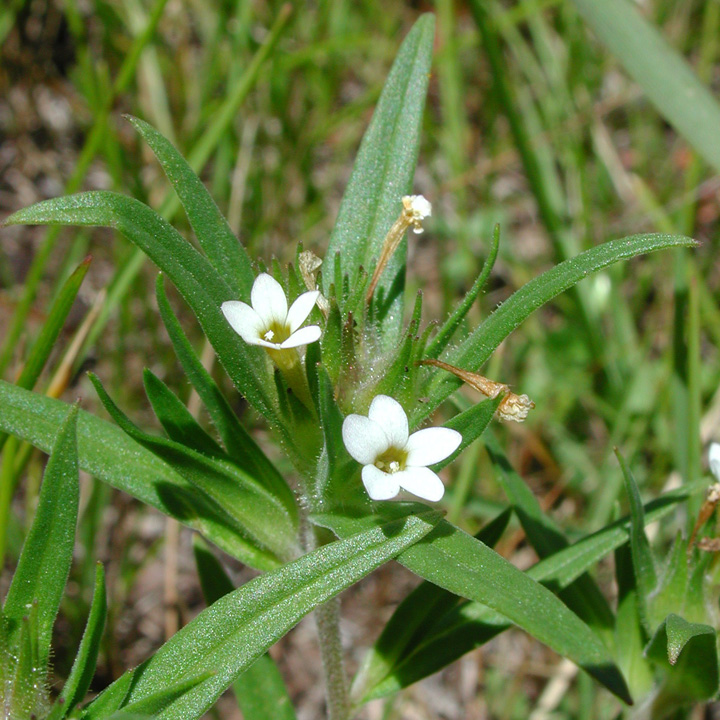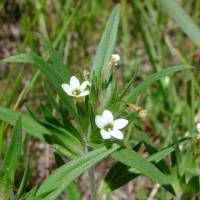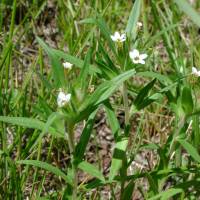PLANT: Annual; stems 1-5 dm.
LEAVES: subsessile, entire, 1-6 cm long, the lower cauline leaves linear to lanceolate, the upper leaves narrowly lanceolate.
INFLORESCENCE: terminal, rarely axillary, compact, the bracts ovate to lanceolate, 8-20 mm long, 3-6 mm wide, the lower margins glandular.
FLOWERS: calyx lobes acuminate; corollas salverform, 8-15 mm long, bluish violet to nearly white; pollen cream to blue; style equal to the corolla tube.
CAPSULE: 3-5 mm long.
NOTES: Open sites, meadows, pine forest: Apache, Coconino cos.; 6500-8000 ft; Jun-Jul-(Sep). W Can to CA and NM.
REFERENCES: Dieter H. Wilken and J. Mark Porter, 2005, Vascular Plants of Arizona: Polemoniaceae. CANOTIA 1: 1-37.
Annual herb 10 - 60 cm tall
Stem: single (though sometimes branching with age), mostly erect, and hairy, especially above.
Leaves: numerous, alternate, usually stalkless, 1 - 7 cm long, 1 - 15 mm wide, linear to lance-shaped, and non-toothed. The uppermost leaves are typically the widest, and grade into very large bracts.
Inflorescence: a terminal, dense, leafy-bracted, tight cluster of essentially stalkless flowers, which are subtended by large, leaf-like bracts, which extend beyond the flower cluster.
Flowers: pink to bluish, or even white, small, 0.8 - 1.5 cm long, 3 - 6 mm wide, radially symmetric, with an elongate, narrow tube, and short, slightly spreading lobes.
Sepals: five, but fused at base, then separating into erect, narrow, lance-shaped, greenish lobes with pointed tips. The sepals are usually firm and papery-textured, but the lobes are often a bit more herbaceous.
Petals: five, much longer than the sepals, but fused for most of their length into a very slender tube, then separating into short, 1.5 - 3 mm long, slightly spreading lobes.
Stamens: five, with short filaments attached at different heights along the inside of the petal tube, but not extending beyond the petal tube.
Pistil: with a single, three-chambered, superior ovary; and a single style with three, linear stigmas.
Fruit: a small, three-chambered capsule with one seed per chamber. When wet, the seeds become sticky and gelatinous (mucilaginous), and produce spiral threads (spiricles).
Similar species: Collomia linearis differs from other genera in the Polemoniaceae family by having simple, alternate leaves, and seeds that exude mucilage and spiraled threads. In the Chicago Region, members of the genus Phlox usually have opposite leaves, more open inflorescences, and more showy, widely spreading petals. Our two representatives in the genera Polemonium and Ipomopsis have compound leaves.
Flowering: May to August
Habitat and ecology: Introduced from further west, occasionally found as a waif in disturbed ground, especially along railroad ballast.
Occurence in the Chicago region: non-native
Etymology: Collomia comes from the Greek word colla, meaning glue or gluten, in reference to the sticky mucilaginous seeds. Linearis means linear, referring to the leaves.
Author: The Field Museum
General: Annual, 10-60 cm tall; stems simple, typically unbranched (sometimes branching in robust plants); herbage puberulent to nearly glabrous towards the base, the pubescence somewhat longer and glandular above; taprooted.
Leaves: Basal and cauline, mostly alternate, lanceolate to linear, 1-7 cm long, 1-15 mm wide, finely puberulent, margins entire; blades sessile or nearly so.
Flowers: Inflorescence a series of congested cymes, these 2-6 flowered; calyx 3-4 mm long; corolla narrowly funnelform, 5-8 mm long, dark blue or violet, the lobes short, ascending; anthers included or a few exserted, but surpassed by the corolla lobes; stigma included; flowers April-June.
Fruits: Capsule, ovoid to ellipsoid, 3-5 mm long.
Ecology: Open sites, somewhat shaded habitats, meadows, pine forests; 2000-2400 m (6500-8000 ft); Apache and Coconino counties; widely distributed across North America, except for southeast and south-central U.S.
Notes: Collomia grandiflora (largeflower mountaintrumpet) is similar to C. linearis, but plants are generally more robust; calyx lobes are acute; and flowers have a larger, yellow to orange corolla (15-30 mm long) with larger lobes (5-10 mm long). It occurs along dry streambeds, on shaded slopes, and in pine forests and oak woodlands at 1400-2400 m (4500-8000 ft).
Editor: Springer et al. 2008
Annual, 1-6 dm, hairy especially above, the main stem and each of the branches (when present) terminating in a dense, leafy-bracteate cluster of essentially sessile fls; lvs numerous, lanceolate to linear, sessile or nearly so, entire, 1-7 cm נ1-15 mm, the uppermost often broadest; cor pink or bluish to white, much longer than the cal, 8-15 mm, with slender tube and short (1.5-3 mm) lobes; filaments short, unequally inserted; seeds 1 per locule; 2n=16. Mostly in dry soil; B.C. to Calif., e. to Wis., Neb., and N.M., and in the Gasp顲egion of Que.; occasionally intr. elsewhere. May-Aug. (Gilia l.)
Gleason, Henry A. & Cronquist, Arthur J. 1991. Manual of vascular plants of northeastern United States and adjacent Canada. lxxv + 910 pp.
©The New York Botanical Garden. All rights reserved. Used by permission.







